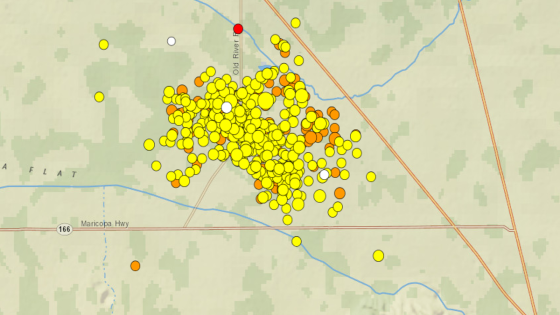More than 400 tremors have followed a 5.2-magnitude earthquake near Bakersfield that sent shaking across Southern California earlier this week.
The quake struck the southernmost end of the Central Valley, about 90 miles north of downtown Los Angeles, just after 9 p.m. Tuesday and was felt throughout parts of Kern, Los Angeles and Ventura counties. In the two days since, there have been 74 smaller earthquakes measuring a magnitude of 2.5 and above within 10 miles of the epicenter of Tuesday night’s temblor.
When taking into account much smaller quakes — tremors measuring as low as less than a 1.0 magnitude — there have been more than 400 in the two days since and within 10 miles of Tuesday’s quake, according to the U.S. Geological Survey.
Aftershocks, mainshocks and foreshocks
Aftershocks are smaller earthquakes that follow a so-called “mainshock,” which is what Tuesday’s 5.2-magnitude event appears to have been, according to California seismologist Dr. Lucy Jones. Aftershocks occur in the same general area as the mainshock and often follow such a quake due to that fault lines lying underneath.
“As a general rule, aftershocks represent minor readjustments along the portion of a fault that slipped at the time of the mainshock,” according to the U.S. Geological Survey.
Along with aftershocks and mainshocks, there are also foreshocks, earthquakes that occur before a larger quake. It appears that Tuesday’s quake was not a foreshock, Jones said that night. In the two days since, there have not been any more temblors of a similar magnitude to Tuesday’s quake.
Jones said Tuesday that there is a 5% chance of any earthquake being a foreshock and that possibility declines in the days following.
“The risk of it being a foreshock drops rapidly with time,” Jones said of the Kern County quake. “By the time we get to three days out, essentially the risk will be all gone.”
“A pretty active sequence”
About one quarter of all aftershocks happen within an hour of the mainshock, Jones explained. There were at least two aftershocks measuring above a magnitude of 4.0 within an hour of the 5.2-magnitude quake this week.
“That’s a pretty active sequence for this very short amount of time since the event,” Jones said.
Tuesday’s quake happened in the same area of a 7.2-magnitude earthquake that struck in 1952, according to Jones. However, she said it appears they are not associated with the same fault.
Source Agencies


